
* Having surveyed the history of the evolutionary idea and basic concepts of taxonomy, this chapter discussed the broad geological history of the Earth, and the humble, if omnipresent, microorganisms known as the "prokaryotes".
* The evolution of life on Earth is intimately associated with the planet itself -- which has evolved as well, as has the entire Universe. It is now known that the Universe came into existence about 13.7 billion years ago in the "Big Bang", as superhot, all-pervasive plasma. Eventually the plasma sorted itself out into atoms, which condensed under the influence of gravity into stars and, from the stars, galaxies. There were no planets as we might define the terms, since all that was created in the Big Bang was hydrogen, a little helium, and a smattering of lithium. There were clouds of gas and stars in the early Universe, as well as balls of hydrogen that were too small to begin thermonuclear fusion and shine as stars.
Among this first generation of stars, however, were very large stars that lived relatively short lives, synthesizing heavier elements, to then tear themselves apart in supernova explosions, scattering the heavier elements to the cosmos. The remains of dead stars, such as dense white dwarfs and denser neutron stars, also occasionally collided, a process also thought to generate heavy elements.
The enhanced mixture of elements in space gathered in clouds, still mostly hydrogen but enriched with heavier elements, that might then collapse into new stars, as well as planets orbiting around them. About 5 billion years ago, our Sun and its planets were formed in this fashion, with the Sun's hydrogen eventually being squeezed by gravity into nuclear fusion, hydrogen being transformed into helium in the Sun's core and releasing energy as it did so. The four inner planets -- Mercury, Venus, Earth, Mars -- were rocky worlds, the warming Sun having blown away their hydrogen and other light gases. The four outer planets -- Jupiter, Saturn, Uranus, Neptune -- were far enough away to retain their hydrogen, becoming gas giant planets.
Originally, there were many small bodies in the Solar System, but they gradually consolidated by collisions into the planets. The Earth and its Moon long presented a puzzle in the formation of the planets, since they are nearer in size to each other than any other planet and any one of its moons in the Solar System. The Earth's Moon is the fifth biggest moon, only smaller than Jupiter's moons Ganymede, Callisto, and Io, plus Saturn's moon Titan.
The Earth-Moon system is sometimes labeled a "double planet". Did the two bodies form together, but separately? Nobody could figure out how that could happen. Were the two worlds formed as a unit, and then somehow separated? What separated them? Was the Moon an independent body captured by the Earth? One would then think its orbit should not be so circular.
It was long known from the density of the Moon that, unlike Earth, it didn't have an iron core. The Apollo Moon landing missions of the late 1960s and early 1970s brought back samples from the Moon, which revealed that Moon rocks were like those of Earth rocks, but the Moon was scarce in volatile elements like hydrogen, nitrogen, carbon, and sulfur.
As understood now, early on, there were two planets in the orbit that the Earth now follows: a "proto-Earth", and another body named "Theia". Theia was originally assumed to be about a third of the mass of the modern Earth, though there have suggestions it was substantially smaller or larger. In any case, they were likely to collide sooner or later, and they did so about 4.5 billion years ago. The collision was off-center; the proto-Earth was badly damaged, while Theta was simply obliterated. Some of the debris from the collision was cast off into deep space, but most of it remained as an incandescent cloud around the battered proto-Earth.
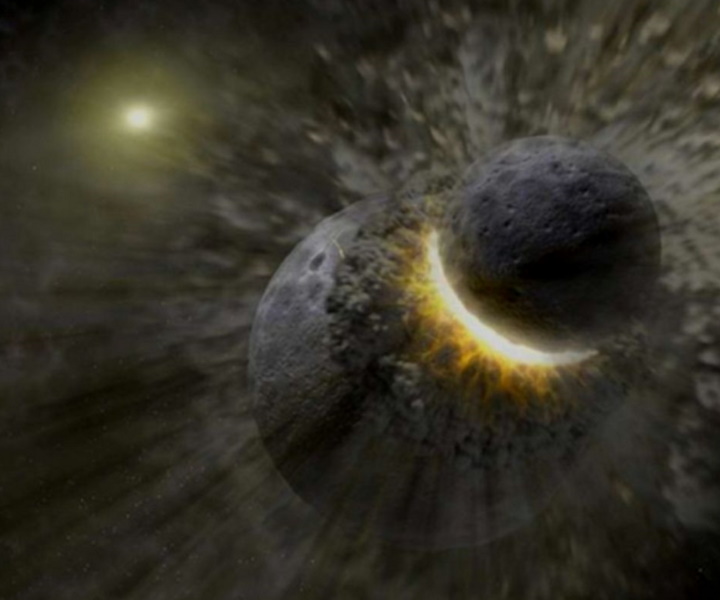
As the system cooled, it formed into twin nuclei, both accumulating material from the cloud. Most of it fell into the proto-Earth, but some of the material fell into the other nucleus, forming a "proto-Moon". Soon they were Earth and Moon, of the size and broad geological composition that they have now. Had the collision been more head-on, the end result would likely have been a single world, of the combined mass of the proto-Earth and Theia. Had the collision been more glancing, the Earth might have ended up with multiple moons. Had the two worlds performed a close encounter but not collided, it would have disrupted their orbits in some unpredictable way.
The Moon formed very close to Earth, only about 24,000 kilometers away -- about a sixteenth of its present distance. It was enormous in the night sky, spanning 8 degrees of arc, about 16 times the diameter of the Sun. When the lunar nearside was facing the Sun, the illumination on Earth was so bright as to flood out the stars. Eclipses were commonplace. The Moon would recede from that, and continues to do so, the recession rate currently being about four centimeters a year.
The Earth was spinning rapidly after its emergence from Theia and proto-Earth, with the day being about five hours long -- though the year was the same length of time as it is now. At that time, the Moon went around the Earth once every 84 hours -- with enormous tides created by the force of gravity between the two bodies, helping them stay molten for longer than they would have, had they being independent. However, within a few million years, they had cooled to form surfaces of hard black rock, though their interiors remained molten, the molten state being maintained to a degree by the decay of radioactive isotopes in the interior.
* Modern geology divides the history of the Earth into a set of "eons", which are subdivided down into "eras", "periods" and in some cases "epochs". The different subdivisions of geological time were originally determined by the fact that they feature distinct sets of fossils. In some cases, the boundaries between the subdivisions are fuzzy and somewhat arbitrary, but in others the boundaries are clear-cut, indicating some relatively abrupt change in the state of the world. The following chart gives the subdivisions, with their beginning dates, with "BY" standing for "billions of years" and "MY" standing for "millions of years":
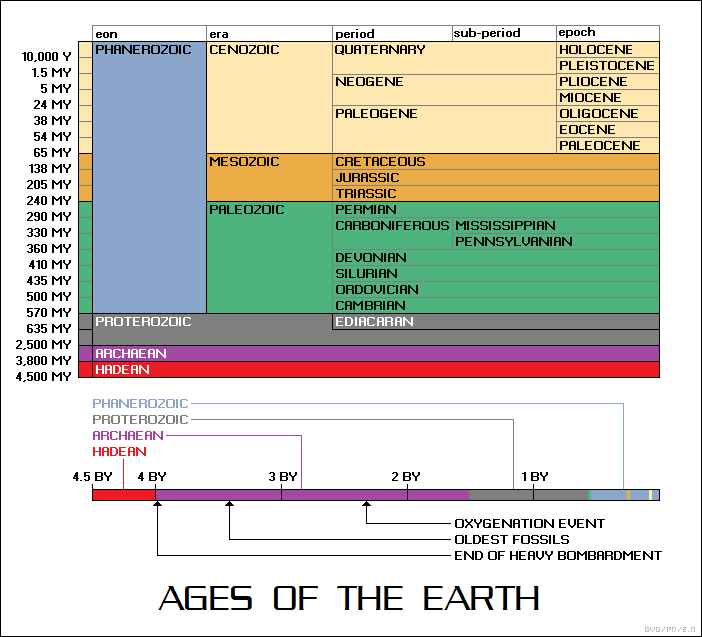
The definitions of the ages in this chart have tended to shift over time, having been standardized in the past few decades by the International Commission on Stratigraphy, organized by the International Union of Geological Sciences. The "Paleogene" and "Neogene", for example, were once lumped together as the "Tertiary", a definition that still lingers. The time before the Cambrian period is often referred to as the "Precambrian" for convenience, lumping together about four billion years of Earth history. From the standpoint of biology, if not of geology, subdivisions of the Precambrian are not all that interesting.
The first of the four eons of the Earth, dating from its time of creation, is known as the "Hadean" -- referring to Hades, the Greek name for the underworld, and reflecting the hellish conditions of the world: widespread volcanic activity, seas of lava, and occasional impacts of asteroids or comets. Some of the impacts were no doubt massive, though none on the order of the Big Thwack.
After the formation of the Earth-Moon system in the Big Thwack, the temperature of the Earth and Moon was on the order of 5,500 degrees Celsius. It wasn't until it cooled to about 1,650C that crystals began to form out of the molten magma in the interior of the Earth. On the Moon, the crystallizations formed predominantly into a mineral named "anorthite" -- which, being lighter than the magma, rose to the surface of the Moon, where it is found today in the form of lunar mountains.
On Earth, the predominant mineral was a hard, greenish-black rock named "peridotite". It rose to the surface as well, but once it solidified, it became denser and sank again -- to be replaced by dark basalts, which also formed the low-lying areas of the Moon. From space, the Earth would have had a dark surface, with red fissures and dotted with volcanoes. Eruptions, along with meteor impacts, were common, resulting in a hellish atmosphere -- the composition of which is not completely known, but it clearly had no free oxygen. The nearby Moon's tides helped keep the crust unstable, while the rapid rotation of the Earth meant storms beyond all human experience.
Effusions from the Earth and the objects falling from the sky often included quantities of water -- and so in time, oceans began to form, roughly 150 million years after the Big Thwack. Water has a number of idiosyncratic properties that reinforce its importance to the planet. One is that, unusually, it becomes less dense when it freezes. If ice were denser, it would sink -- and eventually the oceans would be frozen to their depths, turning the planet into an "icebox".
* About 4 billion years ago, the Earth had more or less stabilized, beginning the second of the Earth's eons, the "Archean". At the time, oceans covered the Earth, the continents not having formed yet. The only surface land consisted of volcanic islands dotting a sea spanning the Earth, rendering it a vivid, uniform blue. The lack of continents meant the Archean sea was very salty, like twice as much as today, since there was little dry land where salts might be sequestered. The Archean atmosphere was rich in carbon dioxide, which combined with carbon dioxide to form carbonic acid, H2CO3 -- with the result that the seas were well more acidic than today.
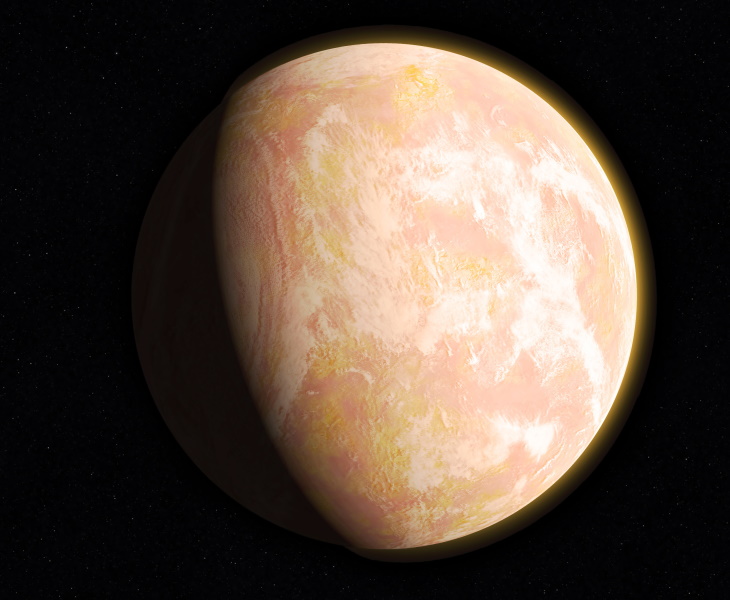
Sunlight was also weaker at the time. The Sun swells as it ages; in the Hadean, it was maybe only three-quarters as bright as it is now. If the Sun became that dim today, the oceans would freeze solid -- but it's obvious there were liquid oceans in the Archean. How?
Of course, one reason was that the Earth itself was well hotter at the time, with volcanic activity much greater than today. That doesn't seem to have been enough to keep the oceans from freezing, with other possibilities being:
Gradually, granitic structures emerged up from the Earth, to form dots of islands over the planetary ocean. As the islands arose, the movements of the basalt seafloor underneath them -- driven by volcanic ranges that extruded the basalt, with the basalt slowly moving across the seafloor, to then return into the Earth at deep-sea trenches -- assembled them into units known as "cratons", which were the building blocks of continents.
By 3.6 billion years ago, the Earth was no longer an ocean world -- though, thanks to "plate tectonics", the slow drift of cratons from the movements of the seafloor, the landmass configuration was not like that we know today. The shuffling around of cratons makes it hard to determine exactly what the configuration of the new Earth really was. Some suggest there was only a single "supercontinent", dubbed "Ur", others claiming there were two.
Also around that time, single-celled life emerged on Earth. The oldest undisputed fossils of microorganisms are about 3.4 billion years old; there are older candidates, but they remain disputed. How life began in the Archean remains a subject of lively investigation, but "abiogenesis" is mostly the concern of biochemists and geochemists. More is said on it later.
BACK_TO_TOP* The first organisms to arise on the planet were the "prokaryotes", including the "bacteria" and the "archaea", the simplest known organisms capable of self-replication. Viruses are simpler, but they can't reproduce on their own -- they are strictly parasites that propagate by infecting cells of proper organisms, and that means there's really no way viruses as such could have come first. Fossil evidence for bacteria goes back over 3 billion years.
The prokaryotes are all single-celled organisms, with simple structures, which could be roughly described as bags of biomolecules. Only about half a century ago, all prokaryotes were thought to be bacteria, but in the 1970s, the American biochemist Carl Woese (1928:2012) used tools for DNA and other biochemical analysis to show that some prokaryotic organisms, generally associated with extreme environments such as hot springs, were biochemically entirely distinct from bacteria. These organisms were originally known as "archaebacteria", but once the idea soaked in of how different they were from bacteria, the "bacteria" suffix became excess baggage and was dropped. As Woese put it: "Archaea display their own characteristic version of every major known macromolecular function." Their biochemical systems are not basically different from those of the bacteria, but their detail operation is distinct.
There are a large number of different phyla of prokaryotes. They come in a variety of shapes, for example spheres ("cocci"), rods ("bacilli"), and more complicated forms such as long floppy coils ("spirochetes") or branched filamentary structures. Many have one or more "flagella", which are spinning whips used like propellers to provide mobility. Some can form "spores", in which they go latent and armor themselves against environmental insults, waiting for their surroundings to improve so they can go active again.
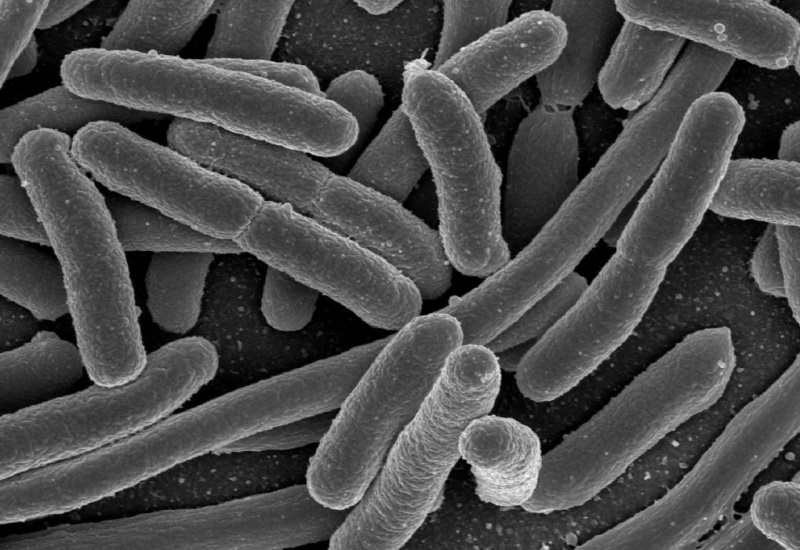
They also have a wide range of ways of making a living. There are two different ways to support metabolism and growth, either as "autotrophs" -- with their existence supported by direct energy sources, such as sunlight -- or "heterotrophs" -- with their existence supported by consumption of other organisms. There are a number of sub-categories:
Prokaryotes can either be "anaerobic", meaning they don't use oxygen and in fact find it poisonous; or "aerobic", meaning they live on oxygen. As a corner case, they can also be "micro-aerobic", meaning they require small amounts of oxygen, but are poisoned by large amounts.
It is clear that anaerobic prokaryotes came first, for the simple reason that the Earth's atmosphere didn't originally contain free oxygen. The anaerobic prokaryotes seem to have mostly obtained their energy from hot springs, volcanic vents, and the like, which no doubt somewhat limited their distribution over the Earth. The Sun being dimmer at the time, organisms were not reliant on sunlight for energy; they could get their energy from the geologically active Earth.
Although microorganisms are stereotyped as pathogens, that's a very simplistic way of looking at them. It is true that many are pathogens, but many are also benign, causing little harm, or have even acquired a symbiotic "partnership" with their hosts. We also use bacteria in industrial processing, for example in chemical leaching of ores and in food production; it's a bit unsettling to realize that when we eat a cup of yogurt, we are essentially eating a bacterial culture.
Prokaryotes reproduce asexually, by budding or fission. Not incidentally, calling prokaryotes "single celled" is slightly misleading, since some species appear as colonial clusters or chains -- any prokaryote that stays linked to descendants after reproduction will form obviously form colonies. However, unlike true multicellular organisms, all the members of a colony are effectively identical. They often exist in "biofilms" that may contain multiple species of prokaryotes, and in some cases the microbial biofilms form large layered structures, known as "stromatolites". Stromatolites still persist in various odd parts of the Earth, for example some bays in Western Australia, but they are rare, only surviving in locales where there isn't much else around to gobble up such a convenient food source. In the Precambrian, they were not rare; they left behind highly distinctive layered fossil formations, some in the form of cones tens of meters high.
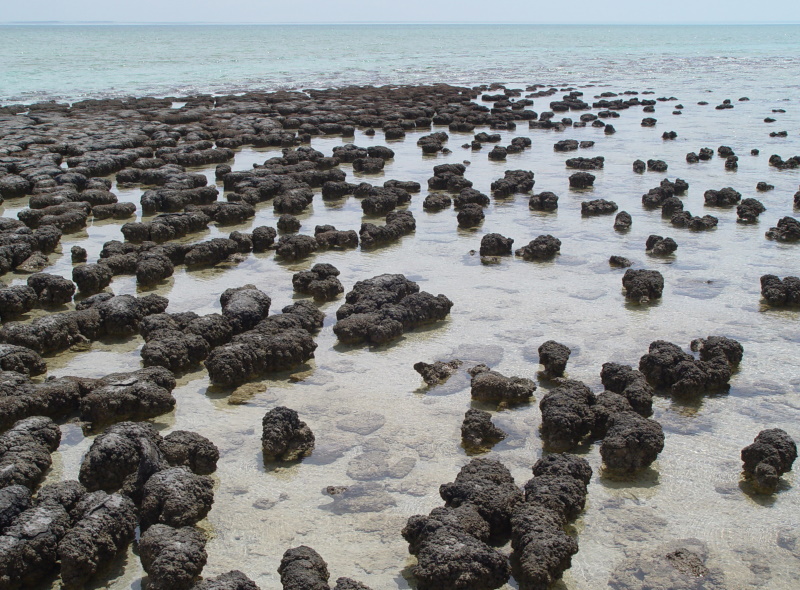
* A good number of prokaryotes are "extremophiles", thriving in environments that are distinctly hostile to most other organisms. The best-known extremophiles are the "thermophiles", or microbes that grow in hot environments, such as hot springs or underwater volcanic vents; as mentioned, the first archaea discovered were found in hot springs. The hardiest thermophiles, the "hyperthermophiles", can actually survive at temperatures above 100 degrees Celsius, the boiling point of water -- for example, the colorfully-named Pyrococcus furiosis, meaning "flaming fireball".
At the other extreme from thermophiles are "psychrophiles", or cold-loving organisms. Hot springs and thermal vents are rare, while cold environments, such as the polar regions and the depths of the oceans, are very widespread. It is not too surprising that life has colonized these frigid domains. There are psychrophilic bacteria that can live in water a degree or two above freezing.
Some extremophiles thrive in highly acidic environments, and are unsurprisingly known as "acidophiles". Others like extreme basic environments, and are known as "alkaliphiles". Highly acidic environments can be produced by the sulfurous emissions of hydrothermal vents and hot springs, as well as in run-off from coal-mine tailings. Acidophiles live in these environments by growing protective coatings; some can live in waters so acidic they would burn human skin. The alkaliphiles live in soils with high concentrations of carbonate and in "soda lakes", which are found in Egypt, the Great Rift Valley in Africa, and the deserts of the western US. Like acidophiles, alkaliphiles protect their internal molecules with a protective coating.
Yet another class of extremophiles are the "halophiles", which can survive in salt ponds and lakes. Cells tend to lose water when living in solutions that are saltier than they are, and so the halophiles cope by creating an even saltier environment inside than outside. Extremophiles are of great interest to biochemical researchers, not only because they are scientifically intriguing, but because they feature enzymes -- protein-based catalysts -- also adapted to extreme conditions, and so potentially useful for industrial processes.
BACK_TO_TOP* Bacteria were originally characterized by their appearance, as well as by what was called the "Gram test", which involved staining the bacteria with a dye, called the "Gram stain"; the stain would not wash off some bacteria but would wash off others, with the two types of bacteria labeled "Gram positive" and "Gram negative" respectively. The scheme was named after its inventor, the Danish scientist Hans Christian Gram (1850:1938). In modern times, molecular and genetic analysis has provided (somewhat) better tools to examine bacteria. Today, we know that while all Gram-positive bacteria are related, all Gram-negative bacteria aren't -- in fact, some Gram-negative bacteria are more closely related to Gram-positive bacteria than they are to other Gram-negative bacteria.
At present, about a dozen different phyla of bacteria are known. That indicates a tremendous diversity, and a purist will observe that this survey is highly unbalanced, giving a very sketchy description of bacteria and other microorganisms, while examining macroscale organisms in more detail, and even then skipping significant but obscure groups among them. However, attempting to give the bacteria and the like all the attention they are entitled to would amount to constructing a microbiology text, and would be gross overkill for a survey.
While it's not practical to cover all the phyla of bacteria here, one of the most significant phyla is the "cyanobacteria", which are photosynthetic bacteria -- sometimes called "blue-green algae", though few taxonomists label them algae, and they're not actually blue-green in color. There are a number of species of cyanobacteria, being often easily observed as "green pond scum", and they are important in maintaining the oxygen in the Earth's atmosphere due to their photosynthetic activities.
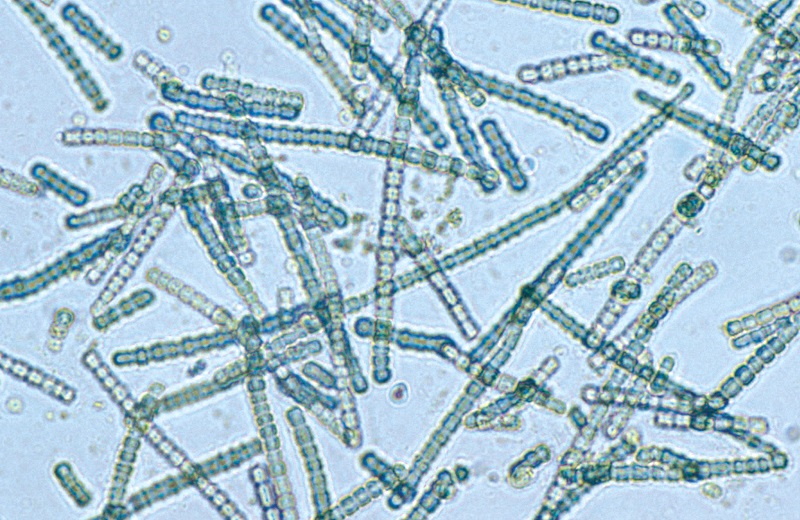
The "proteobacteria" are a fairly diverse group, with a number of prominent members:
The "Gram positive bacteria" are also a diverse group, including:
The other groups of bacteria tend to be obscure, since they aren't generally human pathogens and so don't get public attention; some are also rare extremophiles that are only found in certain habitats. There are still a few well-known bad actors among them -- for example Treponema, a spiral-shaped "spirochete", the agent of syphilis.
* Only five phyla of archaea have been discovered at the last count. The small number appears to be more a symptom of our ignorance of the archaea than a lack of diversity. In fact, some groups of archaea are really only known from DNA samples, their actual forms and lifestyles being somewhat unclear. The archaea tend to be obscure, at least with the general public, mostly because there's no evidence they cause infections in humans or other large land organisms.
The archaea were once thought to be strictly extremophiles -- thermophiles, acidophiles, and halophiles -- but it turns out they are common in the seas, and in fact all "methanogens" -- methane-producing prokaryotes -- are archaeans, these organisms being responsible for producing methane from trash dumps and in flatulence. A few species of archaeans are known to be photosynthetic.
* It should be noted that classifying prokaryotes is uniquely troublesome. It wasn't until the 1930s that they were recognized as a distinct kingdom of life, but they were still described simply as bacteria, with classifications based on superficial features like the Gram stain. Microbiologists knew the classifications were weak, but they had nothing better, and at least they had some labels they could use to communicate with each other.
Woese's discovery of the archaea in the 1970s was a bit of a shock, but microbiologists felt they could use the new molecular tools to nail down prokaryotic taxonomy once and for all. However, all it did was make matters worse. One problem was that the number of species of prokaryotes that can be easily cultured in the lab is very small, estimated to be less than a percent of the total. Incidentally, pathogenic bacteria are generally much easier to culture than benign prokaryotes, because pathogens are adapted to survival in environments hostile to them, the immune systems of organisms being adapted to destroying them. Benign prokaryotes can be much fussier about their living conditions. We tend to stereotype bacteria as malign because of a selection effect.
A bigger difficulty in classifying prokaryotes is that they practice "horizontal gene transfer", passing genes back and forth between different strains and even very different species. Although the phenomenon had been known since the 1950s, nobody had realized how wildly common it is among prokaryotes, or that it could perform jumps between over vast ranges of species -- there's evidence that it occurs between bacteria and archaea. Not only do prokaryotes have the ability to transfer chunks of genes through a sex-like process known as "conjugation", they also could obtain them from viral infections, or even pick up gene fragments from their environment.
There has been some work on coming up with better schemes to classify prokaryotes, but there are pessimists who doubt a clean solution will ever be found. Even in the worst case, however, in practice microbiologists will still have some sort of classification scheme, even if it's not that much of an advance on the ad hoc schemes of the past. The microbiologists still need to be able to talk to each other.
BACK_TO_TOP* Having surveyed the pathogens among the bacteria, there's a certain logic in moving on to discuss the viruses, since they prominent among pathogens as well. However, taxonomists are particularly uncomfortable with viruses. One reason is that it's ambiguous as to whether they can actually be said to be alive: they are obligate intracellular parasites, unable to reproduce except in a host cell. All they effectively amount to is a set of genetic instructions, a "genome", describing how to produce them, encased in a shell of proteins and fatty "lipids" that provides a delivery system. They have no organelles, and no capability for metabolism until they infect a host cell. From an evolutionary point of view, they might as well be thought of as organisms, and so have a "genetic imperative" to spread their genome, the alternative being for their line to die out -- and they do evolve, sometimes with a vengeance.
Viruses consist essentially of a protein "coat" or "capsid", sometimes in a fatty or "lipid" envelope, encasing a genome consisting of DNA or, in some cases, the similar RNA molecule. The genomes of bacteria and other "true" organisms always have double-stranded DNA; some viruses also have double-stranded DNA, but many have single-stranded DNA. Viruses are unique in that some use RNA, either single or double-stranded, as a genome -- for "true" organisms, RNA is only used as part of the machinery to read the genome and produce proteins, never as a genome itself.
All viruses amount to is a delivery system for a genome; they generally include a few enzymes to implement the process. Nobody's exactly sure of where the viruses came from. Some believe they are degenerate descendants of bacteria, others that they began their existence as a means of bacterial gene transfer. They don't lend themselves to fossilization, and are so minimal it is hard to get much insight into their history by examination of their structures. They come in a range of forms: rods, helixes, spheres, and more complicated shapes.
A virus infects a host cell by attaching itself to the cell wall. Some viruses are very picky about what kinds of cells they infect and only attack very specific species of hosts, though others are much less discriminating. After attachment, the virus inserts its genome into the host cell, with the genome then taking over the host cell to produce new viruses. In the end, the new viruses burst out of the cell, killing it.
* Viruses are broadly grouped as "DNA viruses" and "RNA viruses". One of the best-known of the DNA viruses are the "bacteriophages" or "phages", which are parasites of bacteria. They have a number of different configurations, the most famous being that of the "T4" phage. It has an elaborate structure, resembling a bulb containing the viral genome on the end of a rod, with a set of spindly feet on the base of the rod. The feet attach to the cell wall of a bacterium and then the virus injects its genome into the host, almost like a hypodermic needle.
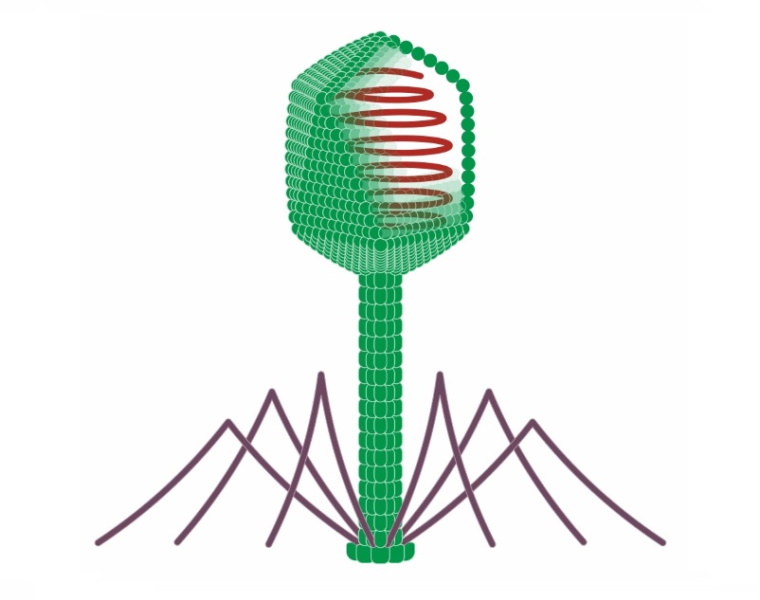
Bacteriophages would not be expected to be of much public interest because they don't pose any threat to humans, but they acquired a certain fame because they are good test subjects for biological experiments. There was also considerable interest in them after World War I as a means of fighting bacterial infections -- the idea was that a patient could be administered a dose of bacteriophages that targeted the bacteria infecting the patient. Interest in "phage therapy" died out in the West before World War II, but the Soviet Union continued to work with the idea, and achieved some success with it. Research on phage therapy has revived to an extent in the West, as bacteria have acquired increasing resistance to antibiotic drugs.
Other DNA viruses include the "herpesviruses", which are spherical viruses associated with oral sores; a set of "wart" viruses that cause warts, which are benign skin tumors, as well as less benign cancers; and the large and complicated "poxviruses", the most notorious being the smallpox virus. Smallpox is extinct in the wild, thanks to global immunization campaigns; it doesn't infect anything but humans. However, the unsettling possibility remains that somebody might try to revive it as a weapon, with the fact that nobody is normally exposed to it any longer making it particularly fearsome.
* One of the most famous RNA viruses is the "tobacco mosaic virus (TMV)", which has a rod-shaped form based on a helical structure and, as its name suggests, infects tobacco plants. While plant viruses are generally obscure, TMV is a popular lab test subject because of its convenience, and because it poses no evident threat to humans or other animals.
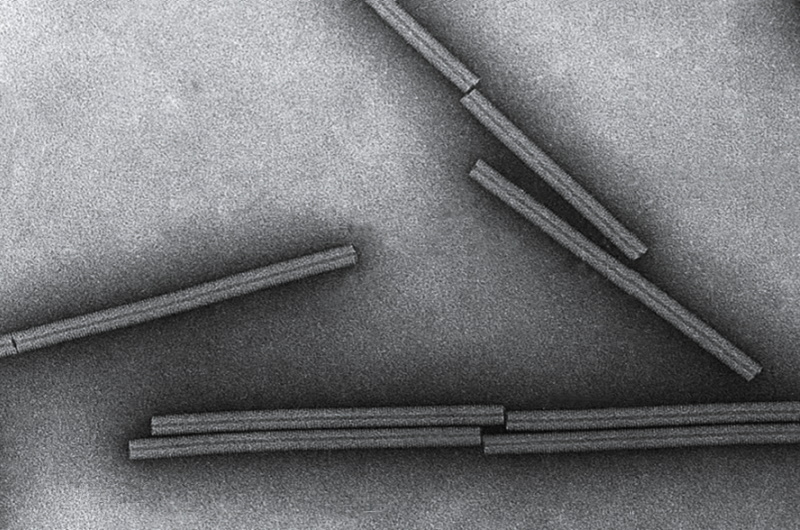
Another well-known RNA virus is the "poliovirus", which is a member of a family of "picornoviruses"; it is a small spherical virus with no lipid envelope. As its name implies, it is the agent of polio, which is a nervous system infection transmitted by dirty water. Modern vaccines have pretty much eliminated it as a threat. Ironically, before modern sanitation was the norm, it wasn't much of a problem, since the human population was generally exposed to the virus and had a broad immunity to it. Other picornoviruses include "rhinoviruses", which are cold viruses, and "apthoviruses", which cause "hoof-and-mouth disease" in cattle.
Other infamous RNA viruses include the deadly yellow fever virus, which is a type of "flavivirus", a class of spherical viruses with a lipid envelope; the rabies virus, which is a "rhabdovirus", a family with large bullet-shaped viruses featuring a lipid envelope, other members including cat and dog distemper viruses; and the ultra-lethal "Ebola" virus, a "filovirus" that causes a devastating "hemorrhagic fever", with a long helical capsid tangled up inside a lipid envelope.
Three RNA viruses deserve close examination, including the "influenza A" virus, "human immunodeficiency virus (HIV)", and "coronaviruses (CoV)". The influenza A virus and related influenza viruses are "orthomyxoviruses", which have a helical protein coat folded inside a lipid envelope. RNA mutates more easily than DNA, and so influenza A tends to mutate rapidly, which is why we don't acquire a lifelong immunity to the flu after being infected with it once.
There is a wide range of influenza strains that infect different sorts of animals; usually a strain that infects one sort of animal does poorly in another, but the possibility remains of a mutant from one strain that proves only too effective in another. The infamous "Spanish flu" pandemic of 1918:1919 that killed tens of millions worldwide was apparently a mutant swine flu. This is the major basis of concerns over "bird flu" -- while it can be lethal in humans who have handled birds, it doesn't transmit easily from human to human, at least for now.
The HIV pathogen, an "RNA retrovirus", is of course the infamous cause of "advanced immune deficiency syndrome (AIDS)". Most viruses inject their genetic code and other components into a target cell to directly take over the cellular machinery to build new viruses. A retrovirus, in contrast, splices its genome into the genome of the host cell, with the virus then replicated as part of what was once the normal operation of the cell.
HIV is a spherical virus in a lipid coat. It infects human white blood cells, which are one of the main arms of the human immune system. This makes HIV particularly sinister, since it directly targets the body's defense systems and very slowly destroys it. AIDS is a very slow-acting disease, and it usually does not kill its host by itself: it grinds down the immune system until the host is taken down by another pathogen, often one that normally coexists peacefully with healthy hosts. HIV is primarily transmitted by sexual contact. There was a ghastly rash of infections early on from tainted blood transfusions, but blood tests were developed to permit screening of blood supplies.
There are other retroviruses besides HIV, one of the most familiar being "feline leukemia virus (FELV)", a common killer of housecats. It has similarities to HIV, but has the reverse effect: instead of destroying the white blood cells of the host, it causes them to propagate out of control, resulting in a leukemia. It can actually infect humans, but it doesn't cause them any real harm.
Finally, the coronaviruses are a group unto themselves, being also spherical. They do not have a lipid coat, but are studded with "spike proteins", giving them a crown-like appearance in a two-dimensional microscopic image, hence the name. They were originally identified as some of the many common-cold viruses, but then became known as the cause of a "severe acute respiratory syndrome (SARS)", making them potentially as dangerous as influenza A. A coronavirus variant knows as "SARS-CoV-2" was the cause of the global "coronavirus-19 (COVID-19)" pandemic of 2020:2022.
Incidentally, very rarely retroviruses, and to an extent other types of virus, will insert their genome into a host germ-line cell, meaning the retroviral genome can be passed down through the generations. Such a "provirus" can actually be expressed in later generations, resulting in a viral infection of a host that hasn't been exposed to the virus -- a phenomenon that greatly confused the first researchers to discover it. The human genome actually has provirus patterns in it, making up a few percent of the entire genome, but they are all broken -- mutations have ensured they can't produce viruses. Our genome contains some provirus sequences that are common to all mammals, suggesting they penetrated the mammal gene line back at its roots.
BACK_TO_TOP